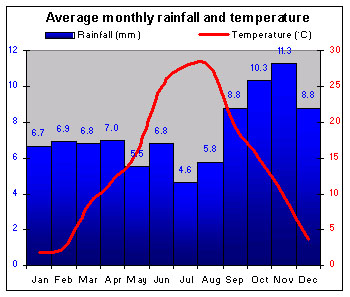COUNTRY INFORMATION |
Introduction |
Perched on the slopes of Mount Titano in the Italian Appennines, tiny San Marino is the world's oldest republic; it has maintained its independence since the 4th century. The territory is divided into nine castles, or districts. One-third of Sammarinesi live in the northern town of Serravalle. Today San Marino makes its living through agriculture, tourism, and limited industry. Italy effectively controls most of its affairs. |
|
Climate |
 |
San Marino's Mediterranean climate is moderated by cool sea breezes and its height above sea level. In summer, temperatures can reach 27°C (81°F), while in winter they fall to 7°C (45°F). There is rarely ever any snow. |
|
People |
|
|
| URBAN/RURAL POPULATION DIVIDE |
|
|
|
Citizenship requires 30 years' residence; it is no longer transmissible by marriage. Women gained the vote in 1960, but could not stand for public office until 1973. Around 20,000 live abroad, mainly in Italy. Some Sammarinesi speak a distinct regional dialect. |
|
Economy |
| GNP (US$) |
190
|
M |
GNP World rank |
185
|
|
| Inflation |
2 |
% |
Unemployment |
3 |
% |
|
StrengthsTourism, providing 60% of government revenue. Light industry, notably mechanical engineering and clothing, with emphasis on sportswear and high-quality prestige lines. Philately. WeaknessesNeed to import all raw materials. |
|
Politics |
| Lower house |
Last election |
2001 |
Next election |
2006 |
| Upper house |
Last election |
Not applicable |
Next election |
Not applicable |
|
San Marino is a parliamentary democracy, headed by two captains-regent elected every six months. Although the PDCS is the largest single party, it is not guaranteed a place in the ever-shifting coalitions.The most recent government, formed in 2002, is headed by the PSS. |
|
Resources |
|
|
| Oil reserves (barrels) |
No data |
Oil production (barrels/day) |
Not an oil producer |
|
San Marino has to import all its energy from Italy. It has no exploitable mineral resources now that the stone quarry on Mount Titano has been exhausted. |
|
Health |
| Life expectancy |
80 |
Life expect. World rank |
2 |
| Population per doctor |
375 |
Infant mortality (per 1000 births) |
6 |
|
|
|
| Principal causes of death |
Heart diseases, cancers, accidents |
|
Health care is free and available to all. There is a hospital, but those requiring difficult operations normally go to Rimini for treatment. |
|
Education |
| Literacy |
99 |
% |
Expend. % GNP |
No data |
%
|
|
| PERCENTAGE OF POPULATION IN FULL TIME EDUCATION |
|
| Primary |
No data |
% |
Secondary |
No data |
% |
Tertiary |
No data |
% |
|
All teachers are trained abroad, mostly in Italy. Secondary school pupils can go on to Italian universities. |
|
Wealth |
| Cars |
No data |
per 1,000 population |
| Telephones |
689 |
per 1,000 population |
| Televisions |
865 |
per 1,000 population |
|
Living standards are similar to those of northern Italy, while the unemployment rate is well below the Italian average.
|
History |
Founded in the 4th century, the Republic of San Marino became one of many medieval Italian city states. It refused to join the unified Italian state created between 1860 and 1871. - 1862 San Marino signs friendship treaty with Italy.
- 1914–1918 San Marino fights for Italy in World War I.
- 1940 Supports Axis powers and declares war on the Allies.
- 1943 Declares neutrality shortly before Italy surrenders.
- 1960 Women obtain vote.
- 1978 Coalition of San Marino Communist Party (PCS) and PSS – sole communist-led government in Western Europe.
- 1986 Financial scandals lead to a new PDCS/PCS government.
- 1988 Joins Council of Europe.
- 1990 PCS renames itself the PPDS.
- 1992 Joins UN. Collapse of communism in Europe sees PDCS/PPDS alliance replaced by a PDCS/PSS coalition government.
- 2002 Adoption of euro.
|
|